Real: Difference between revisions
mNo edit summary |
mNo edit summary |
||
| Line 31: | Line 31: | ||
}} | }} | ||
The '''Real''' ( | The '''Sarpedonian Real''' (Sign:'''₹'''; Code:'''RLS''') stands as the recognized currency within the [[Union of Sarpedonian States]], a regional alliance initially established by [[Cartadania]] and [[Pelaxia]], encompassing their respective territories. Over time, this union expanded to include [[Arona]], [[Talionia]], and [[Volonia]]. The Real, like many world currencies, is subdivided into 100 centavos. Acting as both the central authority and the issuer of the Real, the Reserve Bank of Sarpedon (RBS) maintains offices in [[Vila Real]] and [[Albalitor]], signifying its role in shaping the monetary landscape of this cooperative union. | ||
The inception of the Sarpedonian Real can be traced back to the evolution of regional economic integration. With a basis originating from the former primary circulating currency of Cartadania, it reemerged on the financial stage, officially supplanting the Escudo and Salia currencies on 1 January 2028. This currency transition marked a significant step in the consolidation of economic policies among the member states. Notably, Cartadania continued to produce the Escudo, owing to its economic ties with certain regions that still employ this currency. However, this coexistence ceased on 1 January 2030, with member states shifting toward their respective currencies or the Sarpedonian Real, further solidifying the Real's significance as a unifying currency within the Union of Sarpedonian States. | |||
== History == | == History == | ||
Revision as of 23:50, 19 September 2023
This article is a work-in-progress because it is incomplete and pending further input from an author. Note: The contents of this article are not considered canonical and may be inaccurate. Please comment on this article's talk page to share your input, comments and questions. |
| Real | |
|---|---|
| Real (Cartadanian) Real (Spanish) | |
| File:No-image-available.svg Real banknotes | |
| ISO 4217 | |
| Code | RLS |
| Number | 000 |
| Exponent | 2 |
| Denominations | |
| Subunit | |
| 1⁄100 | centavo |
| Plural | Reais |
| Symbol | ₹ |
| Nickname | Pila, Billetes (plural) |
| Banknotes | |
| Freq. used | ₹1, ₹2, ₹5, ₹10, ₹20, ₹50, ₹100 |
| Rarely used | ₹500 |
| Coins | |
| Freq. used | 1, 5, 10, 25 centavos |
| Rarely used | 50 centavos and €1 |
| Demographics | |
| Date of introduction | 6 September 1694 |
| Replaced | Escudo |
| User(s) | |
| Issuance | |
| Central bank | Reserve Bank of Sarpedon |
| Website | www |
| Printer | Casa da Moeda |
| Website | www |
| Mint | Casa da Moeda |
| Website | www |
| Valuation | |
| Inflation | -2.49% (September 2028) |
| Method | CPI |
The Sarpedonian Real (Sign:₹; Code:RLS) stands as the recognized currency within the Union of Sarpedonian States, a regional alliance initially established by Cartadania and Pelaxia, encompassing their respective territories. Over time, this union expanded to include Arona, Talionia, and Volonia. The Real, like many world currencies, is subdivided into 100 centavos. Acting as both the central authority and the issuer of the Real, the Reserve Bank of Sarpedon (RBS) maintains offices in Vila Real and Albalitor, signifying its role in shaping the monetary landscape of this cooperative union.
The inception of the Sarpedonian Real can be traced back to the evolution of regional economic integration. With a basis originating from the former primary circulating currency of Cartadania, it reemerged on the financial stage, officially supplanting the Escudo and Salia currencies on 1 January 2028. This currency transition marked a significant step in the consolidation of economic policies among the member states. Notably, Cartadania continued to produce the Escudo, owing to its economic ties with certain regions that still employ this currency. However, this coexistence ceased on 1 January 2030, with member states shifting toward their respective currencies or the Sarpedonian Real, further solidifying the Real's significance as a unifying currency within the Union of Sarpedonian States.
History
Tender
Banknotes
| Obverse | Reverse | Value | Main color | Obverse motif | Reverse motif | Current series or withdrawal date |
|---|---|---|---|---|---|---|
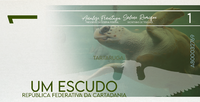 |
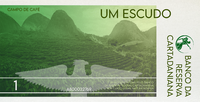 |
1 escudo | Green | Loggerhead sea turtle | Coffee fields and mountains | 2023 series (Current) |
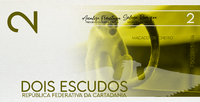 |
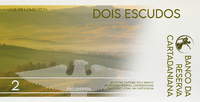 |
2 escudos | Green-yellow | Canotta's squirrel monkey | Lombardia Valley | 2023 series (Current) |
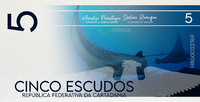 |
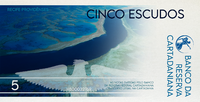 |
5 escudos | Dark blue | Manta ray | Kindreds reef | 2023 series (Current) |
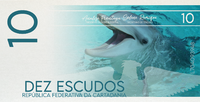 |
 |
10 escudos | Light blue | Bottlenose dolphin | Meranti glade | 2023 series (Current) |
 |
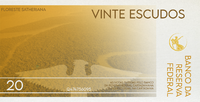 |
20 escudos | Orange | Jaguar | Satherian Rainforest | 2023 series (Current) |
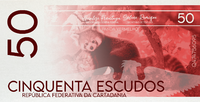 |
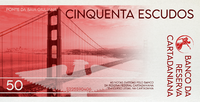 |
50 escudos | Red | Red panda | Giulia Bay Bridge | 2023 series (Current) |
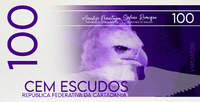 |
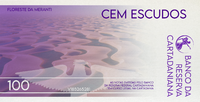 |
100 escudos | Purple | Harpy eagle | Lençois Desert | 2023 series (Current) |
Coins
| Obverse | Reverse | Value | Color | Obverse motif | Reverse motif | Current series or withdrawal date |
|---|---|---|---|---|---|---|
| 1 centavo | Copper | 1¢ | Efígie da República | 2023 series (Current) | ||
| 5 centavos | Silver | 5¢ | Efígie da República | 2023 series (Current) | ||
 |
 |
10 centavos | Silver, gold | 10¢ | Hibiscus | 2023 series (Current) |
| 25 centavos | Gold | 25¢ | Efígie da República | 2023 series (Current) |